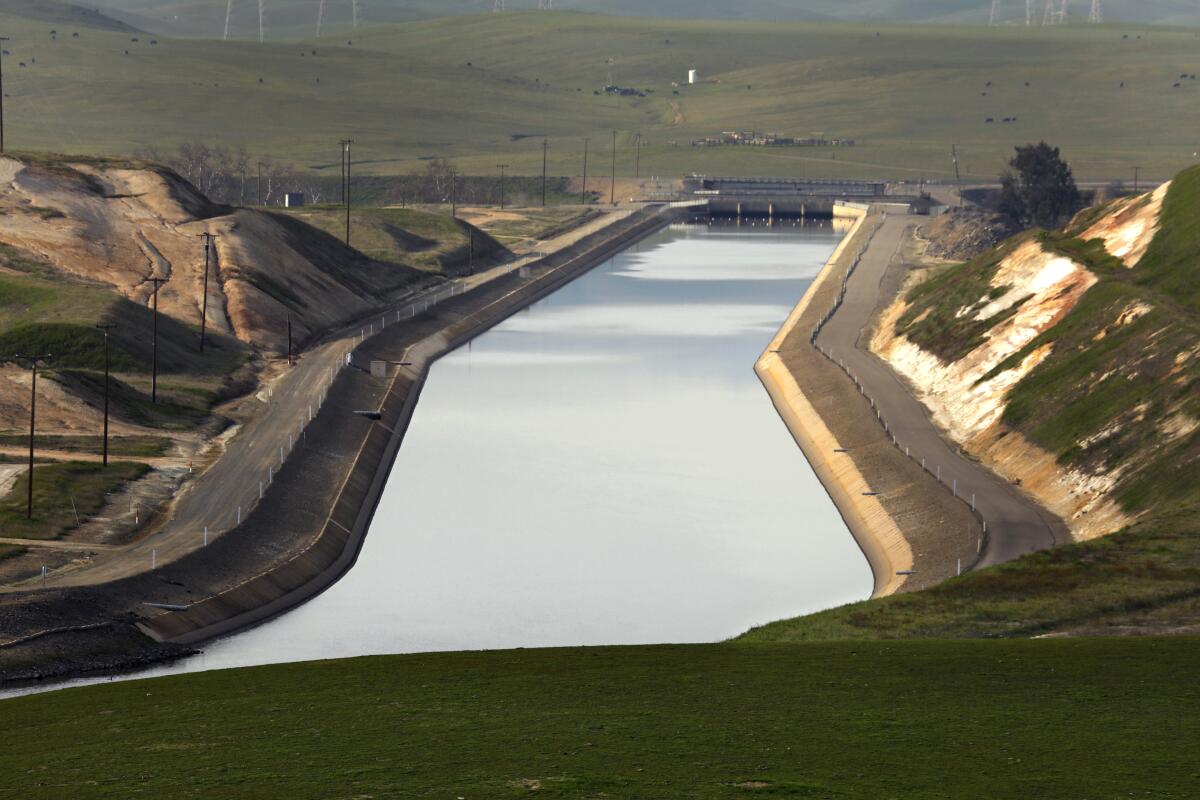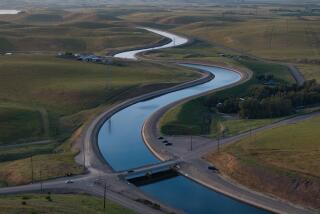As drought persists, minimal water deliveries announced for the Central Valley Project

With California entering a third year of drought and its reservoirs at low levels, the federal government has announced plans to deliver minimal amounts of water through the Central Valley Project, putting many farmers on notice that they should prepare to receive no water from the system this year.
The federal Bureau of Reclamation, which manages the project’s dams and canals, announced a zero-water allocation for irrigation districts that supply many farmers across the Central Valley. Cities that receive water from the project in the Central Valley and parts of the Bay Area were allocated 25% of their historical water use.
“Conditions are very dry. And as a result, we have to be very cautious with these allocations,” said Ernest Conant, the bureau’s regional director.
After a wet start to the rainy season in October and December, the state has gone through an extremely dry stretch in January and much of February. Conant pointed out that January and February are on pace to be the driest on record.
Without those critical months of snow and rain, the state has less to count on to boost major reservoirs, which were already low after two dry years.
Last February, the Bureau of Reclamation started with a 5% allocation for many agricultural water users and a 55% allocation for cities. But the hot, dry conditions last spring shrank inflows from rain and snowmelt much more than projected, Conant said, and the agency decided to reduce allocations to 0% for the irrigation districts and 25% for cities — the same reductions the agency is starting with this year.
“We’re getting a certain amount of criticism from the agricultural community for these low allocations, but we have to be prudent and cautious with these very dry conditions,” Conant said. “If it doesn’t rain in March, it’s possible it could get worse.”
The Central Valley Project stretches about 400 miles from the Redding area to the southern end of the San Joaquin Valley, with 20 dams and about 500 miles of main canals. One of California’s two main north-south water conduits, the project pumps water from the Sacramento-San Joaquin River Delta near the intakes of the other major system, the State Water Project.
The federal government has more than 270 water contracts on the Central Valley Project to supply entities including large irrigation districts, individual farmers and cities.
The project also supplies agricultural water users with senior rights predating the project’s construction, called settlement and exchange contractors, which during critically dry years are still able to receive up to 75% allocations under their contracts.
“There’ll be certain areas in the Central Valley that have some water, and there’ll be other areas that really have no supplemental water,” Conant said. “Those farmers are going to have to rely upon groundwater if it’s available.”
Some areas may be able to obtain water transferred from other sources, Conant said. But given how diminished the state’s water supplies are, he said, “we’ll just simply have to fallow a number of acres” and leave some farmland dry.
The reduced water allocations will affect cities in the Central Valley and parts of the Bay Area served by the Santa Clara Valley Water Agency, Contra Costa Water District and East Bay Municipal Utility District.
Water suppliers in Southern California, meanwhile, have been told to expect 15% of their full water allocations this year from the State Water Project.
The Bureau of Reclamation said its initial allocations for the Central Valley Project, which could still change, are based on estimates of how much water will be available from rain, snow and reservoirs. The total amount of water stored in project’s largest reservoirs has dropped significantly over the last year.
“Our reservoirs are at about 27% of capacity, about 52% of the 15-year average,” Conant said.
December storms bought heavy snow to the Sierra Nevada, but the snowpack has since dwindled to 67% of average for this time of year.
And this winter’s biggest storms have brought relatively less precipitation to the watershed that feeds Shasta Lake, the state’s largest reservoir.
Water releases from Shasta Dam provide critical cold water for endangered winter-run Chinook salmon. But last summer, with the reservoir at low levels, the water flowing from the dam got so warm that it was lethal for salmon eggs.
State biologists estimated only 2.56% of the winter-run eggs hatched and survived to swim downriver past Red Bluff, one of the lowest rates of “egg-to-fry” survival in years.
Advocates for the commercial and recreational salmon fishing industries, which depend on the more numerous fall-run Chinook, criticized how officials have managed water releases from Shasta Dam over the last two years.
“We’re likely looking at another year of decimated natural salmon runs due to water decisions that favor a small group of agricultural landowners over the interests of the rest of California,” said John McManus, president of the Golden State Salmon Assn.
McManus and others have criticized what they say have been excessive water releases from Shasta Dam during the drought, which they say left the reservoir too low last year to continue supplying water cool enough for the fish.
“This highlights the need for more responsible drought planning,” McManus said.
Officials with the Bureau of Reclamation have defended their handling of water releases, pointing out that the amount of runoff flowing into Shasta Lake last year shrank to a record low that went beyond their projections.
State water officials have said they are taking steps to improve water-supply forecasting to account for the effects of climate change on watersheds.
Warmer temperatures have worsened the dry conditions across the West in recent years, increasing evaporation, drying soils and shrinking river flows from the Colorado to the Rio Grande.
“Soil moisture was really low, and as a result a lot of the runoff just sunk into the ground, rather than running off into reservoirs,” Conant said.
He said water managers focus on keeping the water cold enough for endangered salmon downstream from Shasta Dam, but “last year was just very difficult because there simply was not enough cold water.”
“And so we had poor survival, which was expected, and the same could occur this year,” Conant said.
Conant said the dam managers are working with other state and federal officials to ensure cold-water flows for the endangered fish.
“But in a very dry year like this year or last year, the mortality is going to be high, just because there’s simply not enough cold water,” Conant said.
Shasta Lake now stands at 37% of capacity, or 53% of average for this time of year. The agency is aiming to conserve water in the reservoir as much as possible in preparation for late summer, Conant said, when salmon eggs in the Sacramento River will need the cold water.
“Our releases from Shasta are the absolute minimum that’s required,” Conant said. “We’re doing everything we can to hold water in Shasta in order to have the maximum supply available there.”
The Bureau of Reclamation cited worsening runoff projections in a new water supply forecast released by the California Department of Water Resources. The bureau noted that this latest forecast update, between Feb. 1 and Feb. 15, showed a total decrease of 1.2 million acre-feet in the projected annual inflow to four large reservoirs — Shasta, Oroville, Folsom and New Melones.
“Losing over a million acre-feet of projected inflow in two weeks’ time is concerning,” Conant said in a statement. “We’ve got our work cut out for us this year.”
He said the situation calls for “strengthened collaboration and coordination” among different agencies as well as among water users.
In California, agriculture uses nearly 80% of the water that is diverted and pumped for human use in an average year, according to state data. When water is available, the Central Valley Project represents a key source for the agriculture industry.
Westlands Water District, the largest agricultural irrigation district in the county, said the 0% allocation points to a need for California to invest more in water infrastructure, including projects to store surface water and groundwater, and to transport water.
The district said in a statement that it is “disappointed with the allocation” but that dry conditions and the federal government’s obligation to meet state-established outflow and water-quality standards in the Delta prevent the Bureau of Reclamation from making water available to the district.
Westlands said the drought last year resulted in more than 200,000 acres being left fallow and dry in the district. This year is the fourth in the last decade that Westlands and other irrigators south of the Delta have received a 0% allocation.
More to Read
Sign up for Essential California
The most important California stories and recommendations in your inbox every morning.
You may occasionally receive promotional content from the Los Angeles Times.











